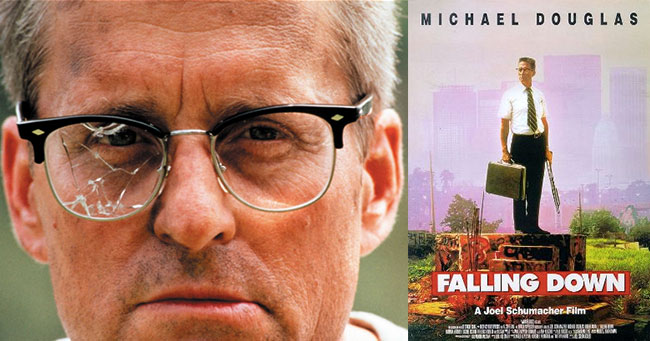I've been doing a lot of writing about frame and lens manufacturers lately, so I decided to take a little break from the serious stuff (okay, so, more serious than usual) and shine a spotlight on something of an optical mystery: Hollywood Browlines.
For ages, these mysterious frames were largely known as the "Falling Down Glasses." For those unfamiliar, Falling Down is a 1993 action/drama film starring Michael Douglas as "D-Fens," an emotionally volatile, laid off defense worker who suffers a breakdown and embarks on a violent odyssey across South Central Los Angeles. The relatively low-key film turned out to be one of the most culturally significant films of the early 90s. Premiering a year after the Rodney King riots, it perfectly captured the festering emotions of Americans on both sides of the political aisle, encapsulating the anger, frustration, racial tension, and world-weary pessimism, which had come to define the young decade. The character of D-Fens became shorthand for a particular type of person, alternatively characterized as either an average American pushed too far or the prototypical "angry white guy." The film was discussed on talk shows, in poli-sci classes, in sociology texts. D-Fens was featured on the cover of Time magazine. In an ironic but appropriate set of circumstances, Falling Down became one of the last films to play at one of Times Squares' notorious grindhouse theaters. In a strange, sad way, D-Fens was the early 90s.
And, for most people, D-Fens was also his browline glasses.
I've already discussed how browlines had fallen out of favor for all but use as sunglasses by the time the 90s rolled around, so giving the character a pair was a perfect way of identifying him as someone left behind by time. Near the film's climax, D-Fens' glasses are smashed during a physical altercation; the image of his scowling face, hidden behind the shattered lenses, became the film's iconic image, reproduced in advertising art and on the film's eventual DVD cover. Though they wouldn't be popularly worn again for another fifteen years, D-Fens helped make browlines a defining image of the decade.

Who made them, though?
Here's where things get interesting…er. More interesting.
Aficionados of Falling Down have long attempted to identify just who made the frames D-Fens wears in the film. My attention was actually first drawn several years ago when I made contact with the webmaster of a Falling Down fan site curious to know if I could identify them. Studying the frames, I realized that they were wholly unique amongst browlines. Vintage browlines tend to be sort of squarish; these were almost a P-3 shape. Diamond rivet covers have occasionally popped up on Ray-Bans, but the frames weren't Clubmasters. They're also often found on low-grade, non-optical quality, dollar store frames, but those in the film clearly hold optical quality glass; and the thin, rolled bridge isn't to be found on any mass-manufacture browline frame I've ever seen. So where did they come from?
After hours of searching, emails to production folks, and reaching out through the grapevine, it seemed as if the frames were wholly unique to the film; they'd either been made specifically for Falling Down, or had been part of some limited stock that the filmmakers just so happened to get their hands on.
Then, one day this Fall, I was flipping through channels and I caught the last few minutes of Death Becomes Her. I haven't seen the movie for years so I'm not going to comment on its' quality, and it didn't really have any social or cultural impact for me to comment on; it's got Meryl Streep, Goldie Hawn, and Bruce Willis, though, so the cast is superb.

And Bruce Willis is wearing the same glasses from Falling Down.
Falling Down was released in 1993, Death Becomes Her in 1992. Falling Down was a Warner Bros. production, Death Becomes Her was made by Universal; two separate studios, making films in different locations, a year apart, using the same, obscure eyeglass frames.
If the glasses were being made specifically by a prop manufacturer, it raises all sorts of questions; real, optical quality browlines were in ready supply from multiple eyeglass companies at the time, and would have more than stood up to the rigors of a physically active film shoot. Having them custom made would have been time consuming and expensive. The alternate theory is that they were, in fact, obtained from a frames manufacturer; but if so, who? And how? Again, there were much more visible companies manufacturing browlines at the time; Willis himself wore Shuron sunglasses on Moonlighting, and Clubmasters weren't in terribly short supply. How did an obscure manufacturer land their even more obscure glasses in two major Hollywood productions?

Both movies are over twenty years old, and the details of such a small aspect of production have probably been lost to time. That said, I'm hopeful that someone reading this might recognize the frames from his or her own dispensary, or remember them from back in the day, and shed some light on this (minimally) interesting little mystery.

Preston Fassel was born in Houston, Texas and grew up between St. Charles, Missouri and Broken Arrow, Okla.
In 2009, Preston graduated Summa Cum Laude with a degree in Liberal Arts. In 2011, he graduated Cum Laude from Sam Houston State University with a Bachelor's of Science.
Preston currently works as an Optician in the Houston area. His interest in the history of eyewear goes back to his time in high school, when he developed an interest in all things vintage.
In addition to his writing for The 20/20 Opticians Handbook and 20/20 Magazine, Preston is a featured writer for Rue Morgue Magazine, where he reviews of horror and science-fiction DVDs. His fiction writing has been featured three times in Swirl magazine, the literary arts journal of Lone Star College and Montgomery County. He is the author of the definitive work on the life of British horror actress Vanessa Howard, Remembering Vanessa, which appeared in the Spring 2014 edition of Screem Magazine.












